
What to do in Madrid in 2 days Visiting Madrid in two days is a truly complicated task considering the city’s numerous attractions: incredible buildings,
Despite the fact that Madrid is one of the largest and most visited cities in Europe, the Spanish capital is a relatively inexpensive city compared to other European capitals like Rome, London or Paris.
Fortunately, there are many activities, exhibitions and free events all the year around in Madrid. Not to mention the museums and monuments which offer free entry options.
I have put together a roundup of free things to to do in Madrid to help you explore my city in the most economical way possible.
Read on to discover the best plans to enjoy Madrid for free or at very economical prices! 😉
The Prado Museum houses one of the finest collections of paintings in the world which was compiled by the Spanish kings over the centuries. This museum is home not only to artworks from the best Spanish painters like Diego de Velázquez, Francisco de Goya and Murillo, but also to works by great European artists such as Rubens, Rembrandt and Van Gogh.
But there is one painting that stands out from the rest, “Las Meninas” by Diego Velázquez. This 17th-century work has become a true icon of Spanish culture that you won’t want to miss.
In total, Prado Museum exhibits more than 1000 works. Therefore, visiting the entire museum in one single day can be really an impossible task. We recommend prioritizing which painters or styles you want to see, otherwise you will end up mentally exhausted.
MY LOCAL TIP! If you are not sure how to organize your visit to Prado Museum, we recommend taking a free map at the entrance. This map shows the most important masterpieces (50 works in total) and how to get to them. This way, it will take you around 2 hours to visit the most important works of Prado Museum.
During the free admission period you can visit only the permanent exhibition. For temporary exhibitions it is necessary to buy the ticket.
-Price: The price of admission for the Prado Museum is €15.
-Free entry: You can enjoy one of the best art galleries in the world totally free every day from 6 p.m. to 8 p.m. (Sunday: from 5 p.m. to 7 p.m.). We recommend arriving about 40 minutes before to queue. (Admission is free at any time for children and youth under the age of 18).
-Address: Paseo del Prado s/n
-Nerest Metro Station: Banco de España (line 2)
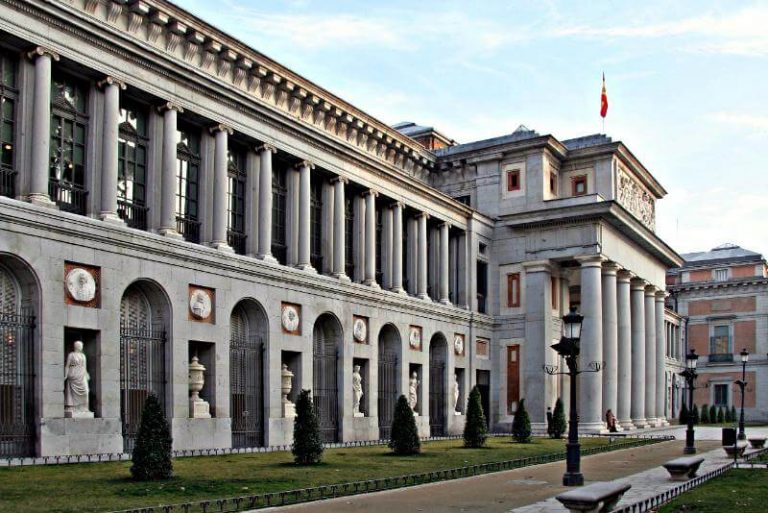
As far as modern art’s concerned, in Madrid you can enjoy great museums and art galleries. However, the Mecca of contemporary art in Madrid is the Reina Sofia Museum, which is considered as one of the best museums of modern art in Europe.
The Museum includes works by renowned artists such as Joan Miro, Juan Gris, Picasso or Henry Moore. But undoubtedly the most famous work is “Guernica” (Pablo Picasso) which represents the bombing of the Basque town of Guernica in 1936.
Reina Sofía Museum also houses a great collection of Salvador Dali’s most famous paintings, including “The Great Masturbator” and “Young Woman at a Window”.
Although the bulk of Francisco de Goya’s work is exhibited at Prado Museum, Reina Sofía Museum also contains a series of interesting engravings that are essential for a better understanding of Goya (“The Whims” and “The Disasters of War”).
-Price: €10
-Free entry: Admission is free for visitors every day from 7 p.m. to 9 p.m. (Sunday: from 1:30 p.m. to 7 p.m.).
-Nearest Metro Station: Estación del Arte (line 1)
-Address: Calle de Santa Isabel, 52
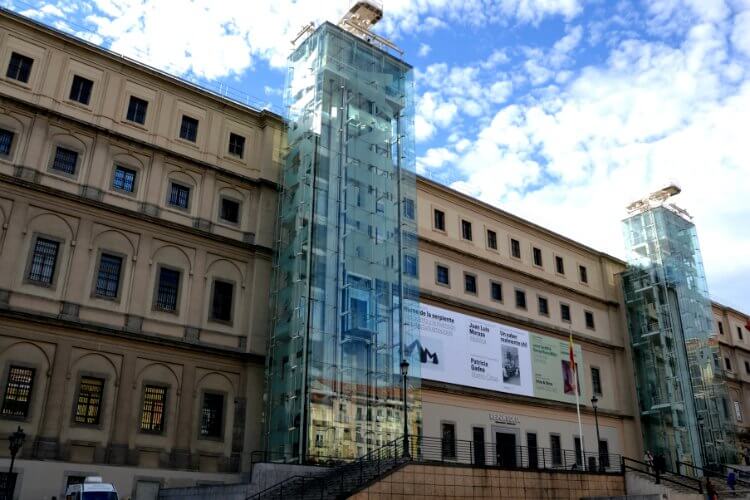
Madrid has the privilege of being home to one of the best collections of private art in the world thanks to the Thyssen Bornemisza Museum. Opened in 1992, this museum came to complement the fantastic collection in the Museo del Prado.
The art collection of this museums is owned by the Thyssen family, a wealthy family of German businessmen.
In this museum, you can admire more than 1,000 works of art from different periods ranging from the 14th to the late 20th century, with special attention to the great European painters, such as Jan van Eyck, Rembrandt and Monet.
The location of the museum couldn’t be better, since it is very close to the Museo del Prado. These two museums, together with the Museo Reina Sofía, make up what is popularly known as the “Triángulo del Arte” (The Golden Triangle of Art).
-Price: Entry to the Thyssen Bornemisza Museum costs €12.
-Free Entry: Mondays from 12:00 to 4:00 p.m.
-Nearest Metro Station: Banco de España (line 2)
-Address: Paseo del Prado, 8
Visited Thyssen-Bornemisza Museum in Madrid with all the best art of the western world. A collection of paintings that would make you weep with joy. One tip; start on the top floor and work down to the modern days.#thyssen-bornemisza #madrid #oilpainting #irishart pic.twitter.com/sWrqDFhyyP
— Paul D’Arcy (@2PaulDArcy) February 19, 2020
If you are a history lover like us, you won’t want to miss this fantastic museum. Our country is located between Africa and Europe and its shores are washed by the Atlantic Ocean and the Mediterranean Sea. Given this strategic position, the Iberian Peninsula has been inhabited by countless civilizations: Phoenicians, Greeks, Romans, Carthaginians, Muslims, Jews, Christians, etc. All of them left their legacy, making Spain a true melting pot of cultures.
The 4 floors of the Museo Arqueológico Nacional offer an exciting journey through the history of Spain, from the Iberian civilization (prior to the arrival of the Romans) to the modern age. Of particular interest are the areas of the museum dedicated to the Muslim era and the Roman legacy in Spain.
Do not expect a depressingly boring museum. The National Archaeological Museum in Madrid offers a truly interactive experience. There are explanatory videos and replicas of objects that you can see up close, even touch them. Your children will love it!
Without a doubt, the crown jewel of this museum is “La Dama de Elche”, a funerary sculpture more than 2000 years old that belonged to the Iberian civilization. This mysterious sculpture, perfectly preserved, has become an icon of Spanish culture.
Spectacular Roman mosaics in National Archaeological museum, Madrid. #MuseumsUnlocked #Spain pic.twitter.com/2oVGKBOdVZ
— Rachel Morris (@MoMarcoPolo) May 17, 2020
Another of the most-visited pieces in the museum is the “Tesoro de Guarrazar“, a collection of crowns and gold crosses adorned with sapphires, pearls and precious stones. This treasure belonged to the Visigoth Kings Recceswinth and Suintila (7th century) and was saved from pillage by the Muslims thanks to its being hidden by a Visigoth cleric.
MY LOCAL TIP! Don’t leave the museum without visiting the reproduction of the Altamira Cave. This cave is located in Cantabria (North Spain) and its cave paintings (ochre and charcoal images of handprints, bison, and horses) date back more than 35,000 years!
According to experts, Altamira cave paintings are amongst the best-preserved paintings worldwide. Of course, the original cave is much larger, but the reproduction of Madrid is astonishing and allows you to admire the most important paintings.
-Price: Entry to the museum costs €3.
-Free entry: Sat from 2 p.m. to 8 p.m. and Sun from 9:30 a.m. to 3 p.m.
-Nearest Metro Station: Colón (line 4)
-Address: Calle de Serrano, 13
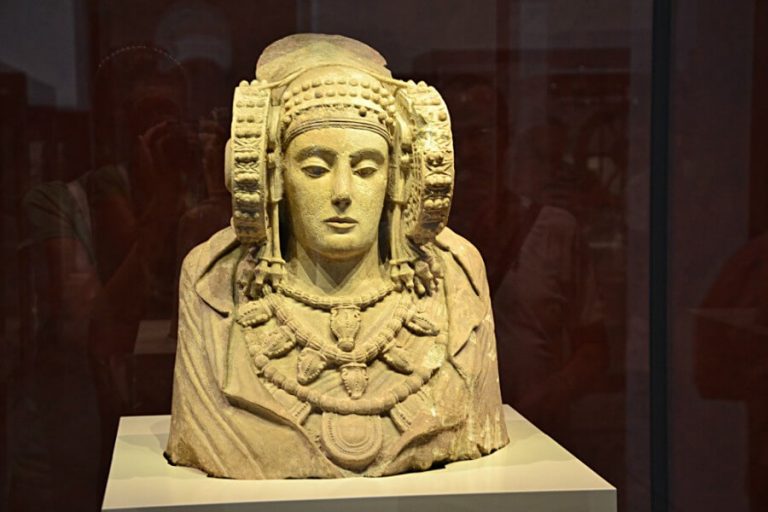
This is one of our favorite museums in Madrid. Throughout the different rooms, you can learn about Spain’s impressive naval history.
You can admire navigation instruments, models of famous ships, old maps, and learn about epic battles and notable people in the naval history of Spain. The museum isn’t very big, but it is quite complete. We recommend buying the audioguide, which will offer many interesting details.
The most-visited piece in the Naval Museum is the first map to ever depict the American continent. This map was designed in the year 1500 by Spanish sailor Juan de la Cosa. On this map, the parts of the Americas that had been discovered up to the late 15th century by the Spanish, British and Portuguese are shown.
-Price: €3
-Nearest Metro Station: Banco de España (line 2)
-Address: Paseo del Prado, 5
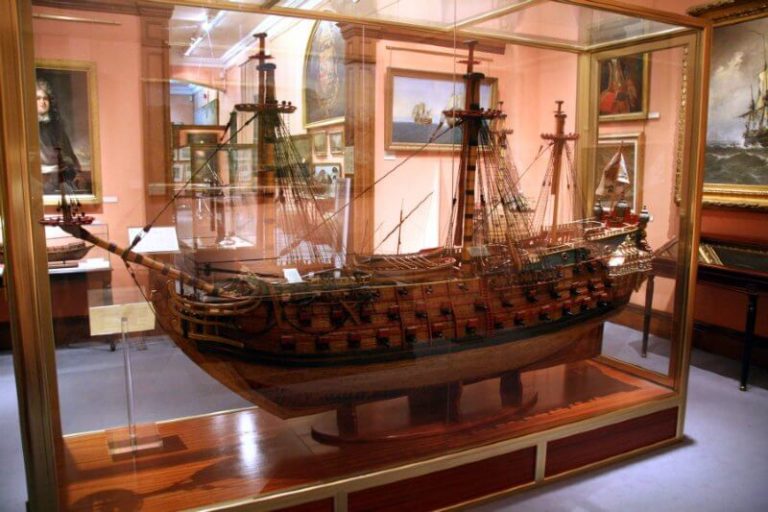
You probably have never heard about Joaquín Sorolla. However, he was one of the best Spanish painters of the 20th century, a true genius of impressionism.
Joaquín Sorolla was born in Valencia, but at the age of 20 his family moved to Madrid. Shortly after, he became part of the social elite of the Spanish capital. Wealthy businessmen and aristocrats adored Sorolla’s paintings.
Few years later, his works were exhibited in New York, Paris or Chicago, and his fame reached new heights.
Despite living much of his life in Madrid, he never abandoned his love for the Mediterranean Sea. Actually, in some of his most famous works, he tried to capture the Mediterranean light. This is why many experts consider Sorolla as “the Spanish Master of Light”.
Sorolla’s house in Madrid is today a museum, which preserves more than 1,200 works, as well as personal objects of the painter. Sorolla lived here until his death in 1923.
-Address: Paseo del General Martínez Campos, 37.
-Nearest Metro Station: Iglesia (line 1)
-Price: €3
-Sorolla Museum Free Entry: Sat from 2pm to 8pm and Sun from 10am to 3pm.
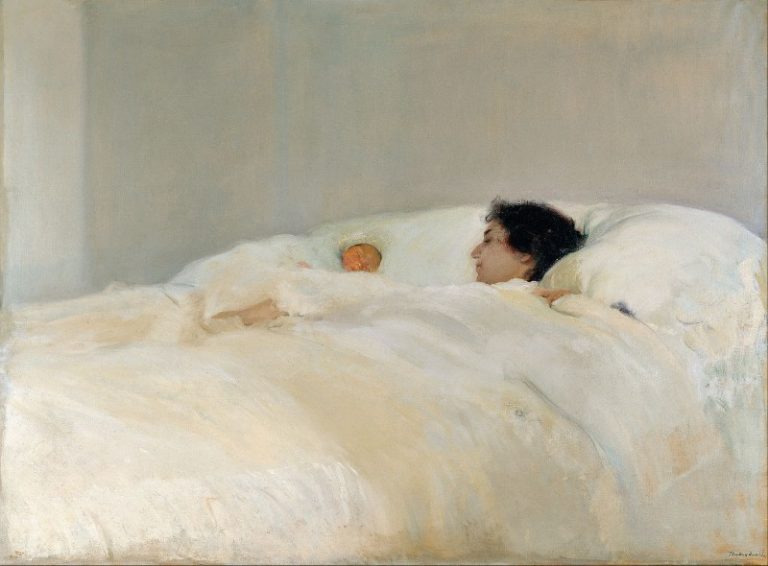
José Lázaro Galdiano was a handsome businessman and successful investor who lived in Madrid in the 20th century. In addition to his astute business sense, Lázaro Galdiano was a great lover of art; he bought and sold works of art frequently in Paris, London and Buenos Aires.
Over the years, Lázaro Galdiano earned a solid reputation in the best social and intellectual circles in Madrid. This way, Lázaro Galdiano accumulated an immense fortune, as well as innumerable works of art, which he exhibited at his wonderful palace in the Salamanca district, still today the most exclusive area in Madrid.
When Lázaro Galdiano died in 1947, he donated all his possessions, including his palace and a library with more than 20,000 copies to the Spanish Government. Shortly after, his palace became a museum that houses more than 10,000 pieces (paintings, sculptures, jewelry, antiques, etc.).
The wonderful collection contains paintings by Murillo, Goya, El Bosco or Zurbarán. Curiously, the Lázaro Galdiano Museum is one of the few in Spain that houses a significant collection of British painting.
One of my favorite parts of the museum is the marvelous jewelry collection that includes pieces from different historical periods (Ancient Greece, the Middle Ages, or the Muslim Spain).
MY LOCAL TIP! Don’t miss the beautiful garden of the Lázaro Galdiano Museum, which was designed in the early 20th century by Italian landscape architects.
-Address: Calle de Serrano, 122
-Nearest Metro Station: Serrano (line 4) / Colón (line 4)
-Price: €7
-Free entry: every day from 2 p.m. to 3 p.m. (closed Mondays).

In the 16th and 17th centuries, cultural development in Spain reached a level never imagined; literary production was prolific, Spanish universities were among the best in Europe and Spanish scientific advances surprised the world.
The admiration of the European nobility and aristocracy was evident; they even imitated the Spanish way of dress and devoured the works of Spanish authors. For example, the French philosopher and historian, Hippolyte Taine said: “There was a peak moment in human history, Spain between the 16th and 17th centuries“.
If there is one person who represents this period of cultural splendor, he is the great Lope de Vega. For many non-Spanish speakers Lope de Vega is completely unknown. However, he was the most important author of his time (17th century). In fact, he is still considered as one of the greatest literary geniuses in history. In total, Lope de Vega is estimated to have written about 1,500 plays, including legendary works as “The Gardener’s Dog“, “Fuenteovejuna” or “The Knight of Olmdeo“.
If you are interested in delving into Lope de Vega, you can visit his original house located in the heart of Madrid. Lope de Vega lived here for 25 years until his death in 1635.
Inside the house you will discover infinite details about his everyday life, his private rooms and even the beautiful courtyard where Lope de Vega relaxed and sought inspiration for his works. An essential visit for all lovers of culture and literature.
Important! To visit the interior of Lope de Vega’s house it is necessary to book in advance (tours available in Spanish, English, Italian and French). Write an email to casamuseolopedevega@madrid.org and book your spots. If you do not book in advance, you can only visit the courtyard.
-Address: Calle de Cervantes, 11
-Nearest Metro Station: Sol (lines 1, 2 and 3)
-Price: Free admission
-Opening Hours: Mon to Sun from 10 a.m. to 6 p.m. / Monday closed
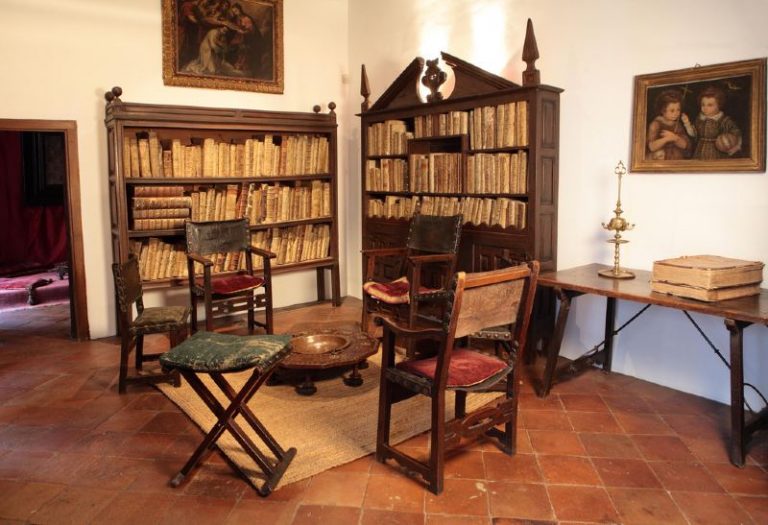
Unfortunately, this is one of the lesser known museums in Madrid. But do not worry, in our eagerness to reveal the hidden (and free) gems of Madrid we have included this wonderful museum.
As its name suggest, the Museum of Americas houses a fantastic collection of archaeological pieces from the American continent. What a surprise 😊! But, in my humble opinion, the part dedicated to American ethnography (science that studies and describes the different cultures of a place) is simply amazing. In total, the Museum of Americas houses approximately 25,000 pieces.
The collection ranges from prehistory to modern times. The part dedicated to pre-Columbian art (Mayas, Incas, Aztecs, etc.) and the colonial period is especially interesting and well documented.
Among all the pieces, the Quimbayas Treasure—made up of 123 gold objects and found in Colombia—is really astonishing. Due to its exceptional artistic quality, this treasure is considered as one of the most important archaeological discoveries in the history of America.
Another piece that you should not miss is the “Stele of Madrid” (7th century), which was part of a throne of a Mayan king and was found in the remains of a palace in Chiapas (Mexico).
-Address: Av.de los Reyes Católicos, 6
-Nearest Metro Station: Moncloa (lines 3 and 6)
-Price: €3
-Museum of Americas Free Entry: Thu from 2 p.m. to 7 p.m. and Sun from 10 a.m. to 3 p.m.
-Free entry at any time: People under the age of 18 and over 65.
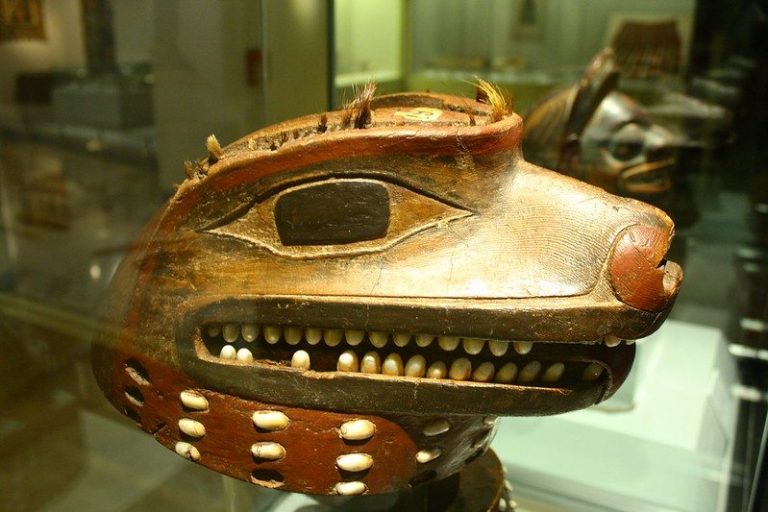
The history of this museum is closely linked to Enrique de Aguilera y Gamboa (Marquis of Cerralbo), one of the most interesting figures in Madrid during the 19th century.
Enrique de Aguilera y Gamboa (1845-1922) was passionate about history and archeology, and during his long life he traveled half the world collecting objects and pieces of great value.
Over the years the Marquis of Cerralbo accumulated a unique and fascinating collection (paintings, armors, rare old coins, busts of Roman emperors, etc.) in his palace in the center of Madrid. Shortly before dying in 1922, he decided to donate his entire collection to the National Archaeological Museum in Madrid.
Visiting this museum always makes me feel marvelous and excited. It’s like traveling back in time. The palace is preserved exactly as it was at the end of the 19th century, including the original furniture (lamps, curtains, desks, etc.). As if this were not enough, all his much-loved and valuable antiques and paintings are intact. Perhaps even the spirit of the Marquis is still in the palace and smiles when he sees how tourists enjoy his wonderful collection.
Some of the most important pieces in the museum are the Portrait of a Knight (Tintoretto), La Inmaculada (Francisco de Zurbarán) and the Portrait of Philip V of Spain, (Miguel Jacinto Meléndez)
-Address: Calle de Ventura Rodríguez, 17
-Nearest Metro Station: Plaza de España (lines 2, 3, 10) / Ventura Rodríguez (line 3)
-Price: €3
-Free entry: on Saturdays from 2 p.m. to 3 p.m., Thursdays from 5 p.m. to 8 p.m. and Sundays from 10 a.m. to 3 p.m.
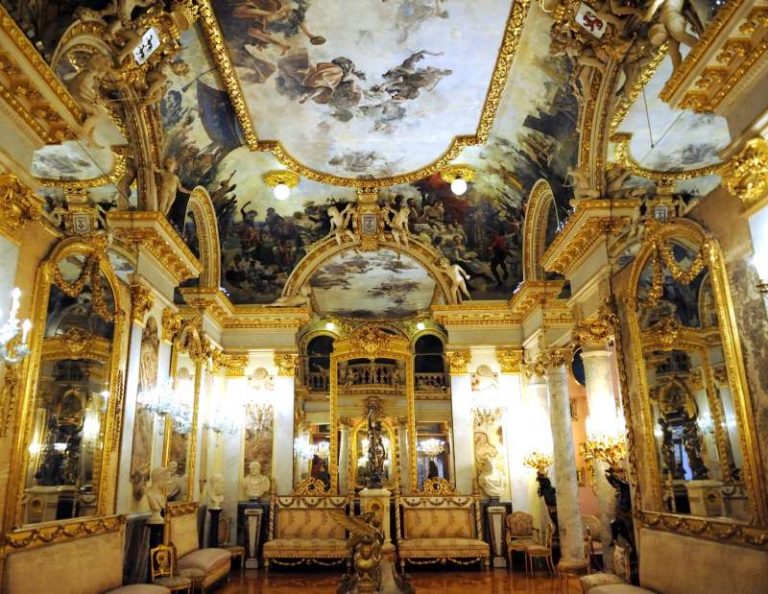
Free tours are always an excellent way to discover a city and delve into its history and traditions.
Madrid is a big city (more than 3 million inhabitants) and its historic center is large. For this reason, I recommend dividing the city into areas to make it manageable.
Specifically, I recommend you start with the Old City, which comprises an imaginary triangle formed by Puerta del Sol Square, the Royal Palace, and Gran Vía Street. Inside this imaginary triangle you will find emblematic places in Madrid such as Plaza Mayor, San Miguel Market, Almudena Cathedral or the statue of the Bear and the Strawberry Tree (symbol of the city).
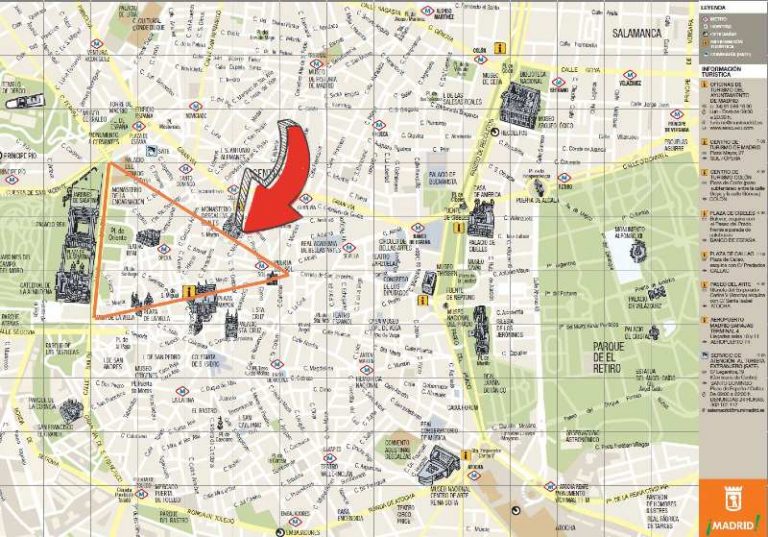
There are dozens of tour operators that offer free walking tours in Madrid. But let me tell you a little bit about OgoTours. Our small local company is one of the most experienced tour operators in Madrid (since 2013). Thanks to this experience we have created a small team of highly qualified and professional guides.
As proof of our passion and hard work to improve, we have received more than 1,000 reviews on Tripadvisor, Facebook and Google.
Unlike other tour companies which have expanded in different cities and even countries, OgoTours is a 100% local business. We are proud of our city and want to offer you a genuine local experience in Madrid. Besides, we also collaborate with other small local businesses (taverns, craft shops, local producers, etc.) which help preserve the essence and traditions of the city.
Learn a little more about our small local company here
Join our Free Tour in Madrid and discover the capital of Spain in a different way (history, architecture, legends, interesting historical facts and much more). BOOK NOW! Every day at 10:45 in Puerta del Sol (Equestrian Statue of King Carlos III).
-Price: Pay-what-you-want option
-Duration of the tour: 2,5 hours
-Address: Puerta del Sol Square (equestrian statue of King Carlos III). Look for the green umbrella of OGOTOURS
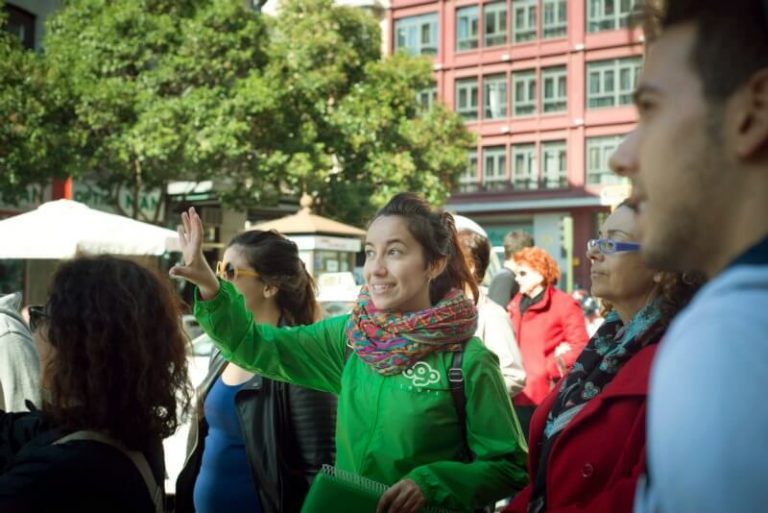
Madrid is a monumental city in many ways: museums, elegant theaters, wide boulevards, imposing buildings. And probably the best example of this is the Royal Palace.
Madrid can boast the largest Royal Palace in Western Europe and one of the largest in the world (135,000 square meters and more than 3,000 rooms!!). Undoubtedly, its huge rooms, sumptuous decor and overwhelming luxury make the Royal Palace a must visit place in Spain.
Imagine visiting the same rooms from where the Kings of Spain ruled territories that spanned from America to the Philippine Islands and from North Africa to Milan or the Netherlands. I am not exaggerating when I say that this palace was one of the most important buildings in the West for almost 200 years.
The palace was built in the 18th century by order of King Philip V. But this site wasn’t selected by chance—this is where the old fortress built by the Muslims in the 9th century once stood. Construction took 17 years, which was a very surprising amount of time for those days considering the size of the palace.
This week, #AlexPolizzi explores the Royal Palace of #Madrid. Tune in on Friday at 9pm. #SpectacularSpainWithAlexPolizzi 🇪🇸 pic.twitter.com/oHuu7Ajh63
— Channel 5 (@channel5_tv) April 26, 2017
Do the Kings of Spain live in this palace? At present the Kings of Spain only use the Royal Pace for official events and receptions. The Spanish Kings reside in the Palacio de la Zarzuela, which is located on the outskirts of Madrid and whose access is restricted.
During your visit to the Palacio Real, pay special attention to the marvelous clocks that decorate the rooms. According to experts, the Palacio Real houses one of the best clock collections in the world.
The visit to the palace includes the armory, in which the weapons and armor of different periods are displayed.
-Price: €13
-Royal Palace Free Entry: If you are a citizen of the European Union or any Latin American country you can visit for free the Royal Palace from Monday to Thursday from 18:00 to 20:00 (From April 1 to September 30) and from 16:00 to 18:00 (from October 1 to March 31). Ticket price for the rest of countries: 10€.
MY LOCAL TIP! It is very important to arrive at least 35-40 minutes before to avoid spending precious holiday time in line.
-Nearest Metro Station: Opera (lines 2, 5 and R)
-Address: Calle de Bailén s/n
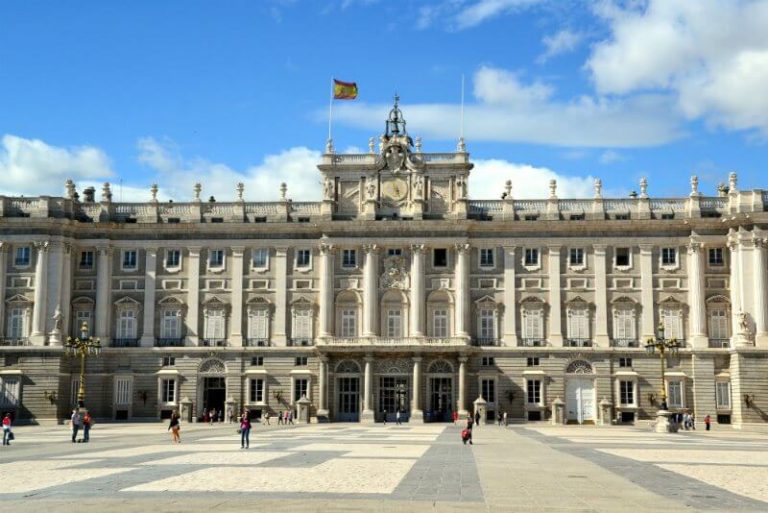
The Palacio de El Pardo was built during the 16th century to house Spain’s royalty when they came to this part of Madrid for hunting. Over the years, this palace became the kings’ winter residence.
However, this palace is popular among Spaniards because it was chosen by the dictator Francisco Franco as his official residence for 36 years. The visit to this palace is very interesting because you can see the dictator’s private rooms, such as his office, his bedroom, etc.
-Price: €9
-Free entry: Wednesdays and Thursdays from 3 p.m. to 6 p.m. (October through March) and from 5 p.m. to 8 p.m. (April through September); free entry for European Union citizens and Ibero-American citizens.
-How to get to El Pardo Palace: Buses from Moncloa multimodal station (line 601)
-Address: Calle de Manuel Alonso, s/n El Pardo (Madrid)
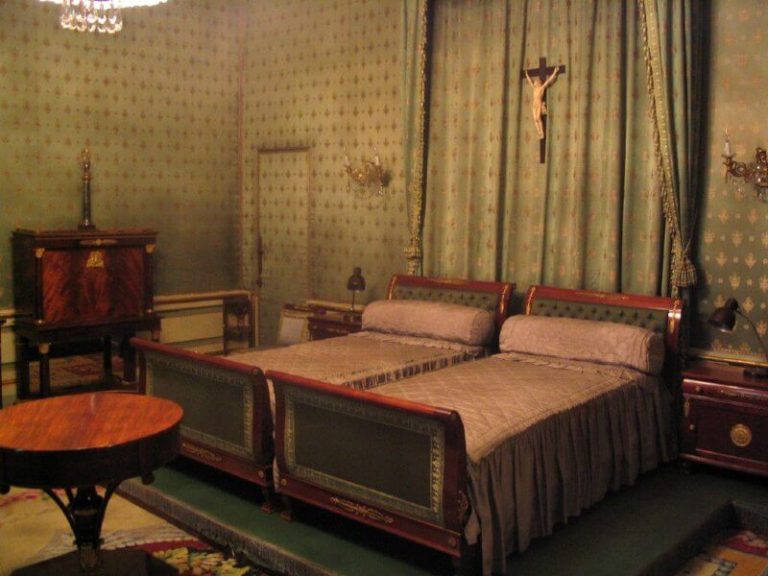
I must confess, as a lover of history, that this is one of my favorite places in Spain. Since I was a child, this place has always been very special to me.
The great work of King Philip II was, without a doubt, the Monastery of El Escorial (16th century). Philip II conceived this immense monastery as a center of religion and knowledge, since it was home to some of the best libraries in Europe.
At the same time, the monastery served as Pantheon to the Spanish royal family. Except for Philip V and Ferdinand VI, every king of Spain has been buried in this monastery, and their tombs can be visited today.
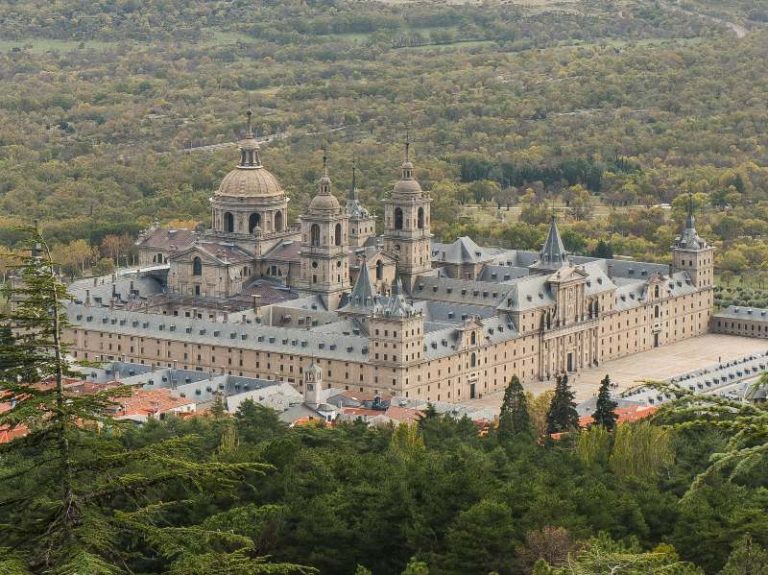
The monastery includes an impressive basilica whose cupula rises 95 meters from the ground, a pharaonic work for its time.
Thousands of workers participated in the construction of the monastery, along with hundreds of oxen which transported the stone from the quarries to the monastery.
The site chosen by Philip II himself to build the Monastery of El Escorial was not chosen at random; Philip II was a man who meditated deeply on every decision. According to legend, this place is home to one of the gates of hell. Philip II, being familiar with this legend, decided to build the monastery here in order to cover this infernal portal.
-Price: The price of admission is €10.
-Free Entry: The Monastery of El Escorial offers free entry Wednesdays and Thursdays from 3 p.m. to 6 p.m. (October through March) and from 5 p.m. to 8 p.m. (April through September) for European Union and Ibero-American citizens.
How to get to the Royal Monastery of El Escorial from Madrid? The monastery is located in a small village north of Madrid (El Escorial), 60km from Madrid. Fortunately, there are commuter trains (line C3) which connect the city center with El Escorial. From Atocha Station it takes approximately 1,5h to get to El Escorial.
-Address: Avenida Juan de Borbon y Battemberg (60 kilometers / 37,5 miles from the city center)
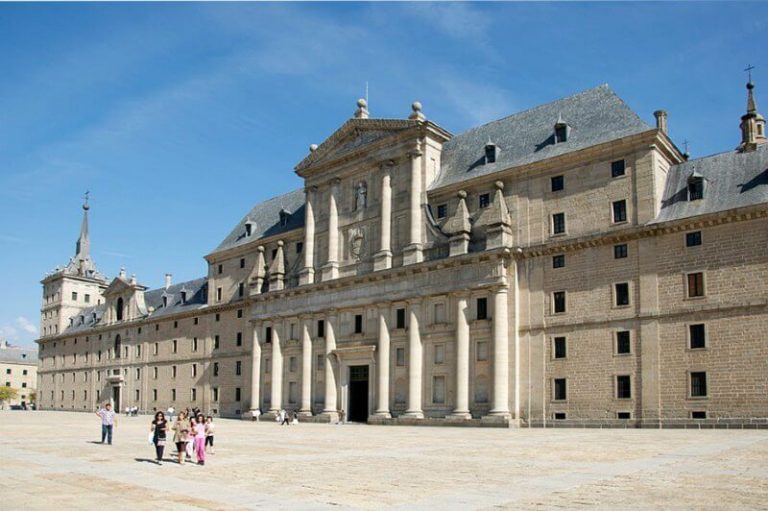
In front of the Royal Palace you can discover one of the most modern cathedrals in the world.
The Almudena Cathedral was inaugurated in 1993 by Pope John Paul II. Despite its short existence, the Almudena Cathedral has lived historical moments such as the wedding of Prince Felipe (now King Felipe VI) or the state funeral of Adolfo Suarez (the first Spanish President after the Franco´s dictatorship).
By the way, during the royal wedding (May 2004) was pouring rain. At least, there is an old saying that goes: “novia mojada, novia afortunada”, which means that if it rains during a wedding, the marriage will be happy.
As you can imagine the interior of the cathedral is completely different from other European cathedrals. The role of modern technology is evident when you visit the building; the colorful stained-glass windows were designed in 2004, or you can find TV screens and Wi-Fi spots throughout the building. Still, it is a beautiful and interesting church which well worth a visit.
We also highly recommend you visit the beautiful crypt of the cathedral (neo-Romanesque) which is situated just below the cathedral.
IMPORTANT! Why doesn’t Madrid have an old cathedral like so many other European cities? I’m glad you asked that question 😊.
Everything happens for a reason in life. Until the end of the 19th century, the city of Madrid belonged to the Diocese of Toledo. In other words, the cathedral of Madrid was always the Cathedral of Toledo. It was in 1885 when the Diocese of Madrid was created, and the construction of the Almudena Cathedral began. Yes, if you do the math, from 1885 to 1993, it took more than 100 years to build the Almudena Cathedral!!!
-Address: Calle de Bailén, 10
-Nearest Metro Station: Opera (lines 2 and 5)
-Almudena Cathedral Free Entry: Entrance is free (€1 donation optional) | If you want to visit the dome and the museum of the cathedral it costs €7.
-Opening Hours Almudena Cathedral:
-From September to June: From 9 a.m. to 8:30 p.m.
-July and August; from 10 a.m. to 9 p.m.
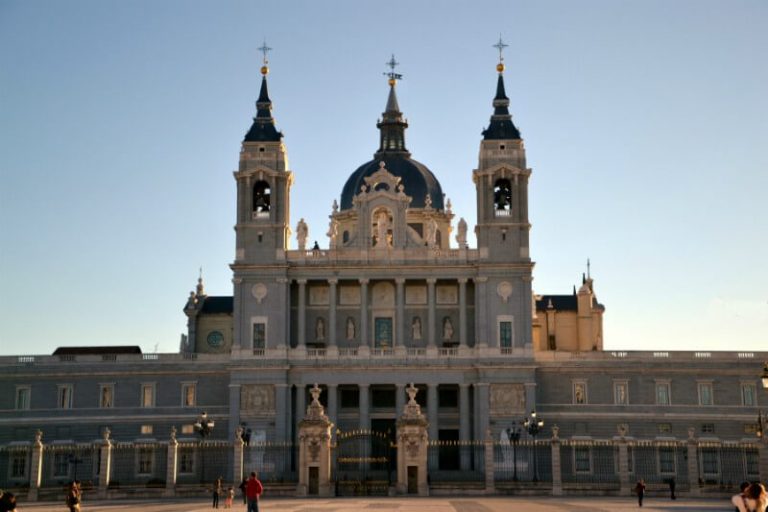
Can you imagine visiting an Ancient Egyptian temple in the heart of the Spanish capital? It’s strange, isn’t it? But yes, Madrid always surprises visitors with hidden gems like this one.
Many people do not know but in Madrid you can visit an authentic Egyptian temple for free. The temple was a gift from the Egyptian Government to Spain in times of Franco (1969) and was dismantled stone by stone and shiped from Alexandria to Valencia. Once in Valencia, several trucks transported the stones to Madrid where the temple was rebuilt.
According to experts, it is difficult to determine the exact date of its construction, although it is estimated that this temple was built approximately 2,200 years ago, which makes it the oldest construction in Madrid 😊
Temple de Debod is an Egyptian temple sat in the middle of Madrid. It’s interesting to visit, but most people find their way there to soak up the absolutely stunning views at sunset – a must do while in #Madrid! pic.twitter.com/uCoPiDBxVu
— Becky (@itsjustbecks_) November 22, 2019
Inside the Temple of Debod there is a small exhibition about Ancient Egypt (mythology, history, etc.) and the entrance is completely free.
Since the temple is on top of a hill, you can enjoy fantastic panoramic views of Madrid, including the Royal Palace, the Cathedral and Casa de Campo. Many locals and tourists visit the Temple of Debod late in the afternoon to enjoy the Madrid’s most outstanding sunset.
-Price: FREE
-Opening Hours: Tue – Sun from 10 a.m. to 8 p.m. (Monday closed)
-Nearest Metro Station: Plaza España (lines 2, 3, and 10)
-Address: Calle Ferraz, 1
This tower, opened in 1992, offers what are undoubtedly the best views of the entire city. A panoramic elevator will take you to the top of the tower, 90 meters (295 feet) high. From up here, you can take in the whole city.
A few panels offer explanations about the most important buildings on Madrid’s skyline. On a clear day, you can even glimpse the Monasterio de El Escorial, which is located more than 60 kilometers (37 miles) from the center of Madrid. The visit is 30 minutes long.
-Price: €3
-Nearest Metro Station: Moncloa (lines 3 and 6)
-Address: Avenida de la Memoria, 2
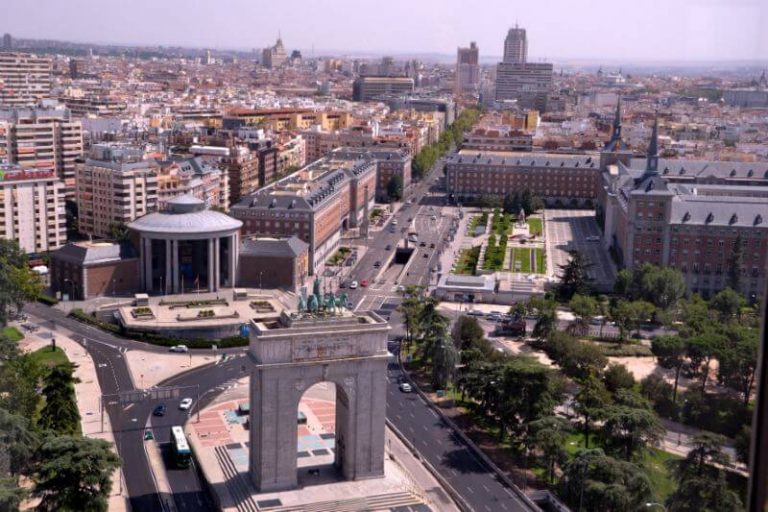
Cibeles Palace hides a pleasant surprise. If you go up to the eight floor you will find a fastastic viewpoint where you can enjoy the best views of the city center: Plaza de Cibeles, the Bank of Spain, Gran Via, Paseo de Recoletos, Torres Colon, Retiro Park, etc.
This majestic building was opened in 1919 as headquarters of the Postal Service and became a symbol of progress and prosperity for the city. Spain did not participate in the First World War and many politicians, intellectuals and businessmen (including their fortunes) took refuge in Madrid.
-Price: 2€
-Nearest Metro Station: Banco de España (line 2)
-Address: Plaza Cibeles
You can’t leave Madrid without seeing Avenida Gran Vía. This avenue dazzles visitors with its elegant buildings, the lights of the advertisements, its theatres and its streets that are filled with people 24 hours a day. Hemingway said that Gran Vía was a fusion of Broadway and Fifth Avenue in New York City.
But if Gran Vía is fascinating at ground level, just wait till you see it from above. In Plaza de Callao, you can go up to the ninth floor of the El Corte Inglés department store. From up here, you can take in incredible views of Madrid’s most famous street. There is also a small terrace where you can have some tapas or a coffee while you enjoy the marvelous views.
El Corte Inglés is the largest chain of department stores in Spain. When Amazon did not exist, El Corte Inglés was the place where Spaniards made all their purchases (clothes, appliances, music, books, etc.).
-Price: €0
-Opening Hours: Mon to Sat from 10 a.m. to 10 p.m. / Sun from 11 a.m. to 10 p.m.
-Nearest Metro Station: Callao (lines 3 and 5) and Sol (lines 1, 2 and 3)
-Address: Plaza del Callao, 2

To tell the truth, there are not many places in Madrid to enjoy panoramic views for free. But, let me tell you our secret to enjoying wonderful panoramic views of Madrid without spending a cent.
“Parque de las 7 Tetas“, (literally Park of the 7 Breast) is not very well known by tourists. Perhaps it is because this park is outside the historic center.
To be honest, this park does not offer the best panoramic views in Madrid, but believe me, it is worth it, especially if you are in Madrid 3 or 4 days. In fact, from here you can take some of the best photos of the Madrid skyline.
This park is located in Vallecas, a traditionally working-class neighbourhood. By metro it takes approximately 20 minutes from the historic center. The panoramic views over Madrid include the old town, the skyscrapers in the financial center, and even the mountains surrounding Madrid.
You are probably thinking why this park is called Park of the 7 Breast, isn’t it?. It is pretty easy. This park has 7 hills which do resemble breasts 😊. Spanish people have a rich imagination…
LOCAL TIP! I recommend visiting the park before dark. This part of the city is not a particularly dangerous, but it is rare to see tourists. When night comes, beggars, homeless, junkies and “strange people” abound. During the day, there is no problem.
-Address: Calle de Benjamín Palencia, 1
-Nearest Metro Station: Buenos Aires (line 1)
-Opening Hours: Open every day of the year (free admission)
The Spanish Civil War (1936-1939) is always a taboo issue among the Spanish. However, it seems as if there was a natural curiosity about that bloody period.
In 1937 Spain was in the middle of a horrible civil war. Madrid, besieged by Franco’s troops, was being bombed and supplies were cut off. Faced with this agonizing situation, the High Command of the Republican Army (the opposing side to Franco), which was installed in a building in the center of Madrid, decided to move the headquarter to a secret place on the outskirts.
The chosen place was El Capricho Park where a huge bunker was built fifteen meters underground to avoid being discovered by Franco’s planes. The total floor area of the bunker was 2,000 square meters.
The bunker is considered by experts to be one of the best-preserved 20th century military buildings in Europe. Despite reconstruction works, the essence of the building has remained intact. When you are inside, you can almost feel the soldiers’ boots resounding, the screams and the explosions in the surroundings of the bunker.
However, there is a small downside to visiting this bunker, access is limited (10 pers. max.). So, it is important to book online well in advance. Unfortunately, the guided tours are only available in Spanish. Despite this, the visit is well worth it since the underground walls and tunnels transport us to another era and speak for themselves.
From the city center you can get here by public transport without problem. Take metro line 5 and get off at El Capricho station.
-Address: Paseo de la Alameda de Osuna, 25
-Price: Free entrance
-Website for reservations: https://www.reservaspatrimonio.es/242-visita-guiada-el-bunker-del-capricho
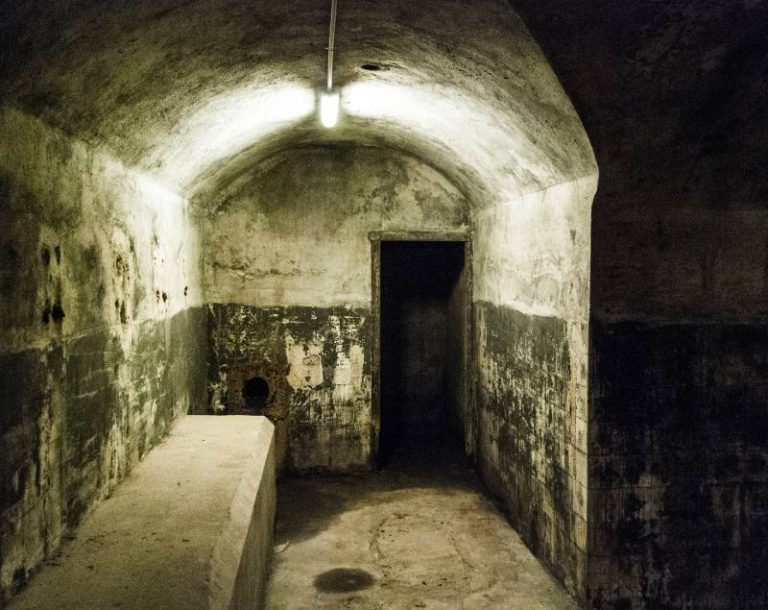
Just imagine a metro station abandoned more than 50 years ago; faded billboards, rickety and rusting turnstiles, old metro ticket machines, etc. time suddenly stopped here. Even the trash bins contain metro tickets from the 60’s. It could certainly be the perfect setting for a horror movie.
Chamberí Station was opened in 1919, however the local authorities were forced to close it in 1966. Since then, this metro station was completely abandoned, keeping all the original elements of that time.
In 2006 the city council had the brilliant idea of turning this abandoned metro station into a museum. Without a doubt, a very interesting visit to discover the evolution of Madrid metro system in the mid-twentieth century (50’s and 60’s).
-Address: Plaza Chamberí s / n
-Nearest Metro Station: Iglesia (line 1)
-Opening Hours: Free entry until full capacity / Thursday: from 10 a.m. to 2 p.m., Friday and Saturday from 10 a.m. to 7 p.m. and Sundays from 10 a.m. to 3 p.m. / Last access allowed: 30 minutes before closing time.
Have you ever heard of Basque Pelota? Basically, it could be defined as a variety of court sport played with a ball using one’s hand, a racket, or a basket. At present, this traditional sport is almost in danger of extinction in Spain, except in the region of the Basque Country (North Spain). However, in the late 19th and early 20th centuries, Basque Pelota was tremendously popular in Madrid to the extent that large “frontones” (sport venue to play Basque Pelota) were built in the city center.
By the end of the 19th century, the Basque Pelota was exclusively popular among the Basque community settled in Madrid. However, at this time Madrid’s high society (including Queen Isabel II) frequented the North of Spain, especially San Sebastian (Basque Country) during their summer vacations, where passion for Basque Pelota was great. In this way, Madrid’s high society discovered the Basque Pelota and brought a taste for this sport to the capital of Spain. Shortly after, Basque Pelota became a mass sport in Madrid.
In this context, the “Fronton Beti Jai” (“always party” in Basque language) was inaugurated in 1894 and had seating for more than 4,000 spectators.
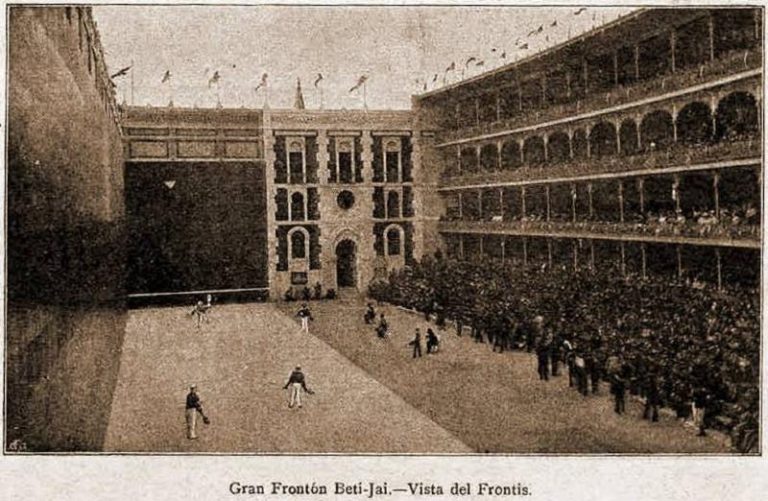
Fronton Beti Jai was a truly spectacular iron frame building with wooden stairs and beautiful frescoes decorating the ceilings. Of course, football already existed but it was not a mass spectator sport yet. Bullfights and Basque Pelota were the favorite form of entertainment of both the popular classes and high society in Madrid.
Unfortunately, in 1919 the Fronton Beti Jai was abandoned. Even during the Spanish Civil War (1936-1939) it was used as a prison to incarcerate government dissidents.
In 2011 the building was declared “Cultural Interest Asset” and was acquired by the Government of Madrid in 2015. Luckily, the building has been faithfully rebuilt and perfectly recreates its original appearance.
Nowadays, the City Council organizes free guided tours in which visitors can learn about the history of this wonderful building.
IMPORTANT! Booking in advance is mandatory https://www.reservaspatrimonio.es/239-visita-guiada-el-fronton-beti-jai
The golden age of Basque Pelota in Madrid took place in two phases: 1892-1895 and 1920-1940.
During the first half of the 1890s, the popularity of Basque Pelota reached levels never before imagined in Madrid. During these years, large frontones were designed: Frontón Madrileño (1891), Jai Alai (1891), Fiesta Alegre (1892), Euskal Jai (1893), or Beti Jai (1894). These frontones had all the comforts you would expect from a luxury theatre and some of them could accommodate up to more than 5000 spectators.
At the same time, professional players became acclaimed sport stars and fans bet huge sums of money during games, which aroused certain misgivings in the most conservative sectors of Madrid society.
Between 1895 and 1920 the interest in this sport in Madrid decreased notably. During this period, many frontones were sold and transformed into theaters, cinemas or even hospitals.
However, between 1920 and 1940 the Basque pelota lived a second golden age. Once again, fans filled up the frontones. The new fever for this sport forced to build new frontons such as New Jai Alai (1922), or Frontón Recoletos (1936).
At the start of the 1950s, the passion for Basque Pelota in Madrid faded. The competition of new sports, especially football, ended up making the Basque Pelota disappear in Madrid.
If you want to go deeper into Basque Pelota in Madrid, we recommend a sensational book called Frontones Madrileños (author: Ignacio Ramos). Unfortunately, the book is only available in Spanish.
Frontón Beti Jai Useful Information:
-Address: Calle del Marqués de Riscal 7
-Nearest Metro Station: Alonso Martínez (line 4) / Rubén Darío (line 5) / Alonso Martínez (line 10)
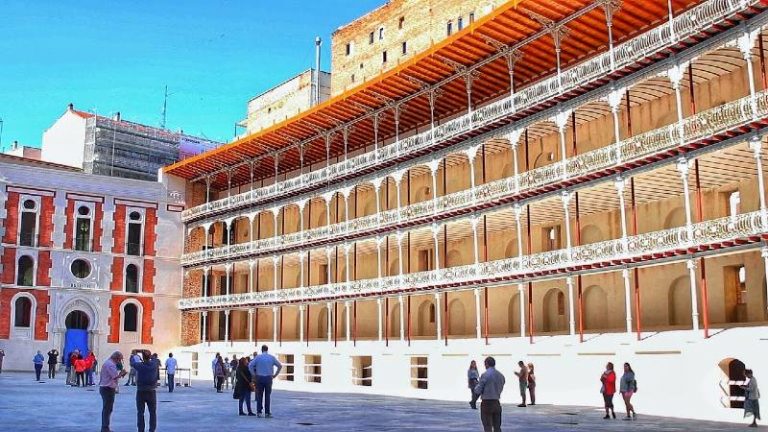
In the Hermitage of San Antonio de la Florida (northwestern part of the city) lie the mortal remains of one of the greatest artists to have ever lived, Francisco de Goya.
What many people do not know is that Goya himself painted in 1798 the wonderful frescoes that decorate the hermitage where he is buried today.
In 1808 Napoleon Bonaparte invaded Spain and the War of Independence broke out. After the war and fearful of the absolutist policy of King Ferdinand VI, Goya went to Bordeaux (France) where he died in 1828.
However, Goya’s mortal remains hide a mystery. A few years after his death, his grave in France was desecrated by someone to steal Goya’s skull. Since then, despite numerous investigations, the whereabouts of Goya’s head remain an unsolved mystery. Some believe it could have been stolen by scientists to study it. The thing is that nobody knows where Goya’s skull is. 😳
In 1889 Goya’s remains (without the skull) were finally transferred from France to Madrid thanks to the efforts of King Alfonso XII.
If you’re going to Madrid, visit hermitage of San Antonio de Florida, a real gem full of #Goya #frescoes #mustsee pic.twitter.com/jPoZ4WKAfG
— Nina Finbow (@NinaFinbow) January 17, 2016
At the beginning of the 20th century, the frescoes of the Hermitage of San Antonio de la Florida -painted by Goya- began to show signs of deterioration due to the smoke from the candles used during the religious masses.
For this reason, in 1925 an exact replica of the hermitage was built 50 meters away. In this way, the authorities managed to preserve the original hermitage, now a museum; the replica of the hermitage is intended for religious worship.
-Address: Glorieta San Antonio de la Florida, 5
-Nearest Metro Station: Príncipe Pío (lines 6, 10 and R)
-Price: Free entry
-Opening Hours: Tuesday to Friday: from 9:30 a.m. to 2p.m. / Saturdays and Sundays from 9:30 a.m. to 3 p.m. and from 4 p.m. to 7 p.m. (closed Monday).
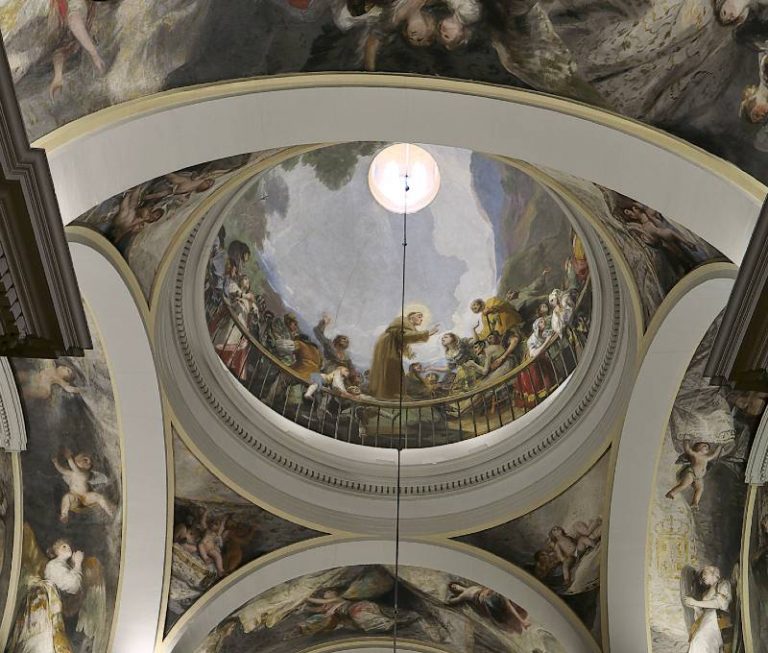
The Pantheon of Illustrious Men in Madrid is largely unknown to many tourists. Surprisingly, not even many locals visit this place.
The Pantheon of Illustrious Men was built at the end of the 19th century to house the mortal remains of important political and military figures: Cánovas del Castillo, José Canalejas, Eduardo Dato or Ríos Rosas. In total 11 illustrious figures of the 19th and 20th centuries who changed the course of history in Spain. So, if you are interested in the modern history of Spain, this is one of these hidden gems to be discovered.
IMPORTANT! Francisco Franco, probably the most influential political figure in the Spanish twentieth century, is not buried in this place. Franco is buried in the Mingorrubio cemetery (located 20 kilometers from the city center).
Each illustrious figure has a really spectacular funerary monument made of white marble. In my modest opinion, the most interesting funerary monuments are dedicated to:
(Jose Canalejas and Canovas del Castillo were both assassinated by anarchists).
-Address: Calle Julián Gayarre 3
-Nearest Metro Station: Atocha Renfe (line 1)
-Price: Free entry
-Opening Hours: Tue-Sat from 10am to 2pm and from 4 p.m. to 6:30 p.m. / Sun and holidays from 10 a.m. to 3 p.m.
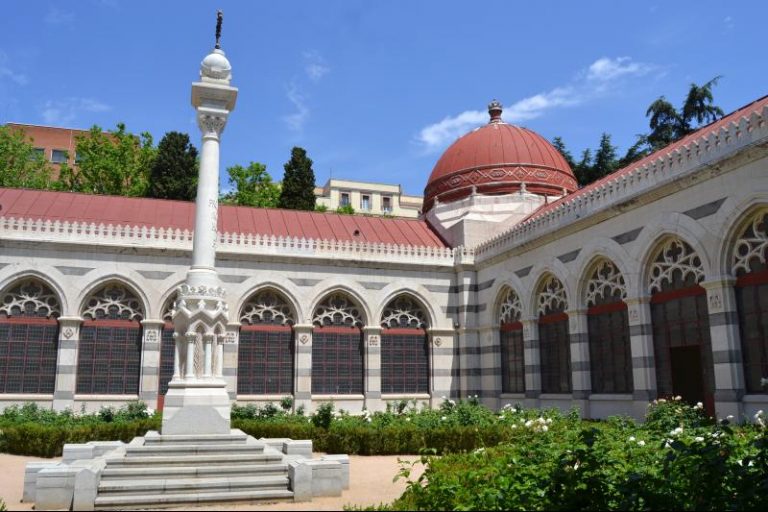
My perfect plan for a Sunday morning in Madrid is to have a coffee with churros in a bar close to where I live, take the metro, and spend the whole morning at the El Rastro Flea Market looking for some bargains.
El Rastro Flea Market, or simply “El Rastro” as the locals call it, was established more than 250 years ago. Since then, every Sunday morning dozens and dozens of stallholders set up to sell their wares. According to estimates, there are approximately 3,000 stalls, which makes it one of the largest flea markets in Europe.
What fascinates me the most about this flea market is that you never know what you will find. Like the Portobello market in London or Waterlooplein in Amsterdam, at El Rastro you can find literally anything: out-of-print books, old toys, 19th century artwork or simply trinkets.
As a lover of books and history, one of my favorite parts of the market is the area between Calle del Carnero and Calle de Carlos Arniches, where you will find old and second-hand books.
MY LOCAL TIP! After an exciting morning shopping I am always hungry. I recommend you visit some of the traditional bars near El Rastro, such as Casa Amadeo-famous in Madrid for its snails with tomato sauce- or Bar Santurce-renowned for its delicious sardines from the Cantabrian Sea-.
-Address: La Latina Neighborhood
Nearest Metro Station: La Latina (line 5)
Price: –
-Opening Hours: Sundays and bank holidays. Opening hours are approximate since each stallholder is authorized to sell whenever they want between 9 a.m. and 3 p.m.
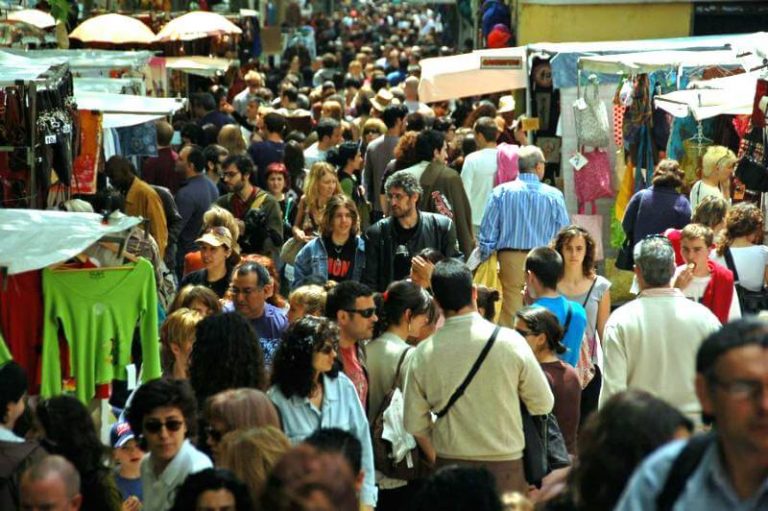
The small town of Torrejón de Ardoz (30 kilometers from Madrid city center) is home to one of the most surprising parks in all of Spain, it is Europa Park. Can you imagine visiting the Eiffel Tower, the Atomium (icon of Brussels), a Greek Theater or the Belém Tower on the same day and without leaving Madrid? It’s perfectly possible 😊
This 233,000 square meter park has 14 replicas of the most important attractions in Europe!!! The London Bridge, the Brandenburg Gate, the Trevi Fountain, and many others.
These replicas are made with great detail and level of realism. Even the park has an original part of the Berlin Wall, donated by the German capital. As if all this were not enough to spend an incredible day, the park has large green spaces, a children’s area, a skating rink, and much more. In short, this park has everything to spend a fun day out.
There are two ways to get to Europa Park (30 kilometers from the city center):
-Bus (line 224-A) from Avenida América Station. The bus will drop you off at Parque Catalunya, very close to Europa Park.
-Commuter Train (line C2) from Atocha Station. Once in Torrejón de Ardoz, you will have to take a city bus (L1 or L2) to get to Europa Park.
-Price: free entry
-Opening Hours:
-June, July and August: from 9 a.m. to 12 a.m. / Friday and Saturday: from 9 a.m. to 1 a.m.
-April, May and October: from 9 a.m. to 10 p.m. / Friday and Saturday: from 9 a.m. to 12 p.m.
-November, December, January, February and March: from 9 a.m. to 8 p.m. / Friday and Saturday: from 9 a.m. to 9 p.m.
Personally, this is one of my favorite plans when visiting a new city. Traditional markets are like small temples that preserve the flavor of tradition and popular wisdom. In other words, when you visit a traditional market you can learn a lot about the city and its inhabitants.
Historically, Madrid has boasted of the quality of its markets. The best products from other Spanish regions are sold every day in the capital’s markets: fresh fruits, vegetables, meats, cheeses, even fish. Yes, fish! Despite that the coast is far away, fresh fish arrives in Madrid every morning (the average annual per capita consumption of fish in Madrid is one of highest in Europe).
Unfortunately, new buying behaviors, competition from large supermarkets and fast-paced life are causing the disappearance of traditional markets in much of Spain. But don’t despair, there are still some old survivors in Madrid which are still frequented by locals.
Not far from the city center, we recommend you visit the “Mercado de Santa María de la Cabeza” (near Atocha Train Station), and the spectacular “Mercado de Maravillas” (near Santiago Bernabéu Stadium).
The traditional markets in Spain have changed a lot in the last decades but there are some elements that remain unchanged such as the vendors yelling their prices, the colorful stalls, or the smell of fresh fish. I absolutely love it!
MY LOCAL TIP! Try to visit these markets during the week. This way you will be able to enjoy the atmosphere, talk to vendors and appreciate the wonderful stalls in detail. On Saturday markets are crowded with locals (Sunday closed).
-Market of Santa María de la Cabeza:
-Market of Maravillas:
Madrid has the privilege of being the capital city with the most trees in Europe, and the second in the world, second only to Tokyo (Japan). In total, more than 300,000 trees are planted throughout the city. A good part of these trees is concentrated in the following parks:
-Retiro Park
-El Capricho Park
-La Casa de Campo
-Madrid Río
As a “Madrileño”, El Retiro Park is my favorite place in Madrid. The beauty of its gardens and trees, the funny squirrels or the romantic pond always comfort me, especially in autumn when El Retiro Park is extremely beautiful. I still remember with nostalgia when I lived for a few years near this park and came here almost every day.
It may not be as popular internationally as Central Park in New York or Hyde Park in London, but believe me, this park is a must-see place in Madrid.
These beautiful gardens were designed in the 17th century for the Kings of Spain, who spent long periods in the nearby Palacio del Buen Retiro (now destroyed). However, in the middle of the 19th century it became a public park.
MY LOCAL TIP!
Nowadays El Retiro is tremendously popular among locals and tourists (approximately 8 million visitors each year!!). Therefore, I always recommend visiting El Retiro during the week, especially in the morning when locals are at work. During the weekend it is almost impossible to walk in the park or find a place to sit.
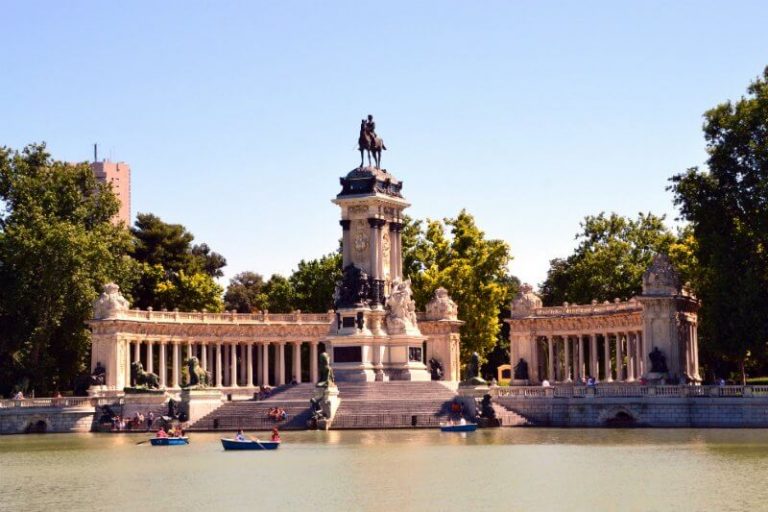
The most popular areas of the park are:
El Estanque: This artificial pond or estanque was designed in the 17th century by King Philip IV, who liked to recreate epic naval battles in the pond. Apart from its recreational functions, the pond also serves as a reservoir of water to supply the numerous fountains in the park. On one of the banks of the pond stands the majestic monument to King Alfonso XII, built in the early 20th century.
The Glass Palace: This beautiful building was built in the late 19th century as part of an exhibit about the Philippines (a former Spanish colony) that was held in Madrid. The purpose of this building was to serve as a greenhouse where visitors could admire plants and flowers brought for the exhibit. Today, the Palacio de Cristal has been converted into a hall where artworks from the Reina Sofía Museum of Modern Art are shown.
Monument of the Fallen Angel: Madrid is a peculiar city, and proof of this is that the first sculpture in the world dedicated to the devil was built here. The sculpture, made from bronze, shows the devil twisting as a serpent coils around his legs. Coincidence or not, this fountain is situated at an official altitude of 666 meters above sea level.
Besides the numerous tourists and locals who enjoy the park each day, Parque de Retiro is also home to a good number of squirrels, ducks and peacocks that are used to tourists and are relatively easy to spot. Without a doubt, this is one of our favorite free things to do in Madrid.
-Price: FREE
-Opening Hours: October – March (from 6 a.m. to 10 p.m.) and April – September (from 6 a.m. to 12 a.m.)
-Nearest Metro Station: Retiro (line 2)
-Address: Plaza de la Independencia, 7
Believe me, this is one of the best hidden gems to explore in Madrid!
These lovely gardens, unknown to most tourists who visit Madrid, were designed by the Dukes of Osuna in the late 18th century. Here, they created a small paradise away from the city where they would hold private parties for Madrid’s high society (writers, painters, deputies, members of royalty, etc.). Many people don’t know, but the Duchess of Osuna was an important patron of the great Spanish painter Francisco de Goya.
During the 19th century, Capricho Park fell into disrepair and was finally acquired by the Madrid Government, which rehabilitated the park and opened it to the public at the end of the 20th century.
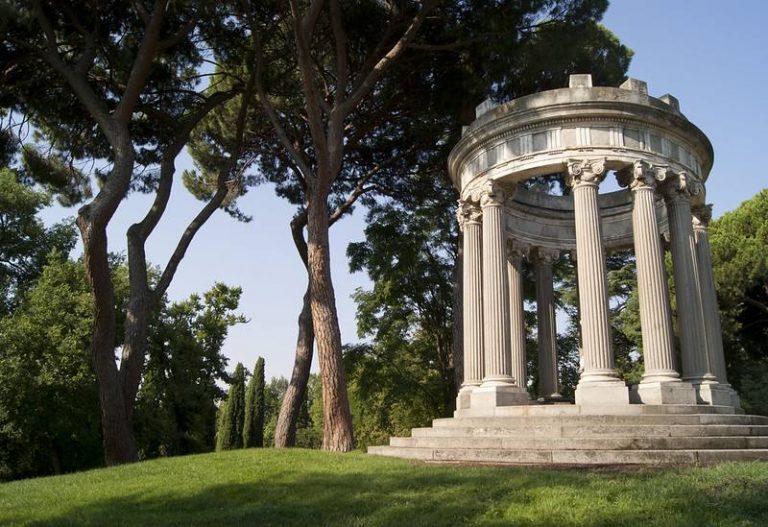
The botanical richness is really incredible, with more than 40 different species (oak, pine, cypress, yew, cedar, etc.). Plus, the park has a very interesting architectural heritage: hermitages, temples, fountains and even the palace where the dukes lived.
But perhaps the park’s best-kept secret is an antiaircraft shelter built during the Spanish Civil War (1936-1939), which was used by the army of the Popular Front.
The only downside to this park is that it is located far from the historic center. To be more exact, Capricho Park is located in the eastern part of Madrid, not far from the airport, so you will need to use public transport. But that is not a problem at all, public transport in Madrid works great!
Important Info:
-Price: FREE
-Nearest Metro Station: El Capricho (line 5)
-Capricho Park Opening Hours: Capricho Park open on weekends and holidays. From October 1st to March 31st: Saturdays, Sundays and holidays from 9 a.m. to 6:30 p.m. / From April 1st to September 30th: Saturdays, Sundays and holidays from 9 a.m. to 9 p.m.
-Address: Paseo de la Alameda de Osuna 26-32
The history of this beautiful park, located in the heart of Madrid, dates back to the Middle Ages. When the Muslims besieged Madrid in the 12th century, they set up their camp in this area of the city, hence its peculiar name, “Campo del Moro” (The Field of the Moor).
When Madrid became the capital of Spain (1561), the Spanish royal family settled in the Royal Palace and turned Casa de Campo into their private hunting ground. King Felipe II, one of the most important kings in the history of Spain, even ordered in the 16th century to bring elephants, dromedaries, rhinos, lions, ostriches, etc. from Africa. These animals were living in the park and delighted the high society of Madrid.
In the 20th century, the park ceased to belong to the royal family. Given this situation, the government of Madrid, Casa de Campo became a public park open to all Madrilenians
If you like to be in touch with nature, you won’t be disappointed. There are dozens of species of different trees: pines, poplars, oaks, heathers, etc., as well as a good number of animal species, such as ducks, squirrels, owls, foxes, etc. There is even a pond where you can fish for carp. Important! Only “catch and release” fishing is permitted.
Unfortunately, a small cliff separates the palace from the gardens. Given this situation, visitors cannot directly access the gardens from the palace. Yes, I agree. It is a real shame…
The entrance to the gardens is located at the west end of the gardens (about 30 minutes walking from the Royal Palace). Of course, kings and distinguished guests did not have to walk that far. There is a tunnel that connects the Royal Palace directly with the gardens. At present, this tunnel is inaccessible for tourists. Fingers crossed that one day it will be possible to visit this tunnel 😊
-Price: FREE
-Nearest Metro Station: Casa de Campo (lines 5 and 10)
-Address: Paseo Puerta del Angel, 1
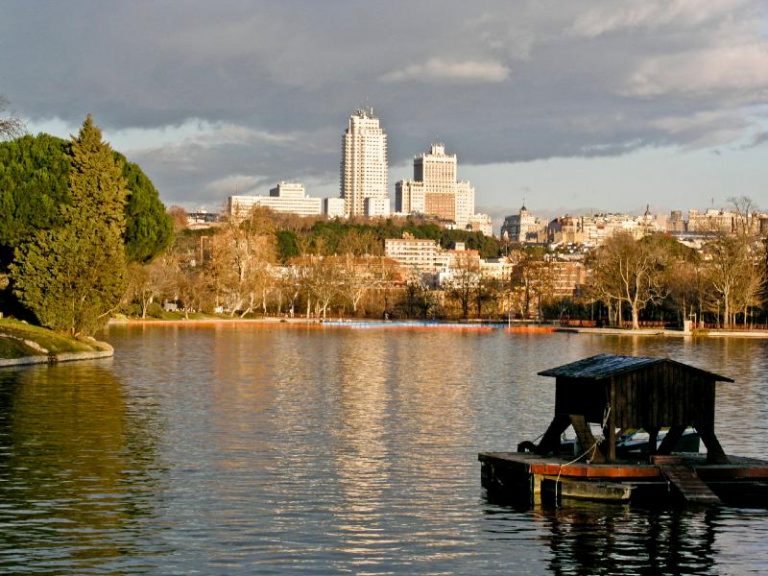
Although it may seem incredible today, not many years ago in this part of the city there was one of the capital’s busiest and most congested ring roads. However, at the end of the 20th century the local government decided to redirect the ring road underground and turn the area into an urban park with fountains, bike lanes, children’s areas, etc.
Manzanares River runs parallel to Madrid Rio Park. Well, maybe we are exaggerating a little bit because Manzanares River is famous for its low flow, almost dry whole of the year. Usually, madrileños we make jokes about the ridiculous river flow.
If you like cycling, Madrid Rio is the ideal place. The park has several kilometers of bike lanes. In addition, the park is part of the so-called “Green Belt“, thirty kilometers of bike lanes that run through much of the Madrid region.
Do not miss the futuristic bridge designed by Perrault, which has become one of the icons of the city.
-Nearest metro Station: Puerta del Ángel (line 6), Marqués de Vadillo (line 5)
-Opening Hours: 24/7
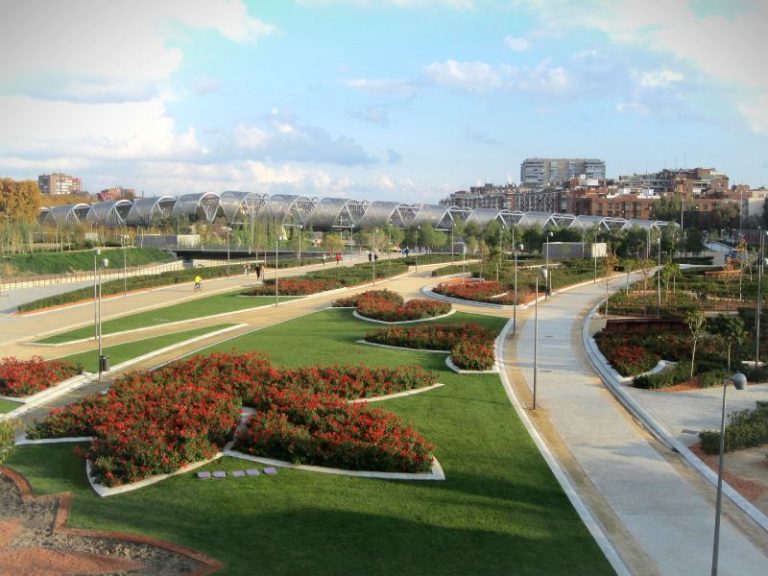
These nice gardens are great to take a break and recharge after a long day visiting the city. In addition, it provides wonderful views of the northern façade of the Royal Palace, especially at sunset. Without a doubt, it is one of my favorite corners of the city in spring.
Formerly this place was occupied by the stables of the Royal Palace, which were designed in the 18th century by Francesco Sabatini. In 1931 Spain became a Republic and the government decided to expropriate the palace complex. Thereupon the government demolished the old stables to build these beautiful gardens. As a tribute, the gardens were named Sabatini (the architect who had built the old stables in the 18th century).
The central part of the gardens is occupied by a pond which is surrounded by a labyrinth of hedges with geometric shapes. The gardens are also beautifully decorated with fountains and statues of different kings related to the Hispanic monarchy. Each of these limestone statues is over 300 years old and were initially designed to decorate the cornice of the Royal Palace, though they were never placed there.
Are you a history buff? Among all the statues in the gardens, there are two particularly important: Isabella and Ferdinand (the Catholic Monarchs), founders of the modern Spanish State.
-Address: Calle de Bailen 2
-Nearest Metro Station: Opera (lines 2 and 5)
-Price: Free entry
-Sabatini Gardens opening hours:
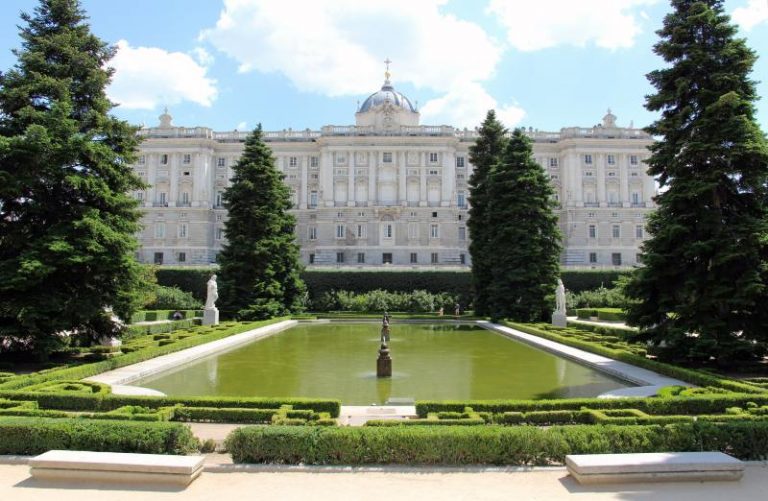
Madrid was one of the pioneer cities in Europe in the transformation of former industrial sites into cultural areas and green spaces. A good example of this is “El Matadero”, the old Madrid slaughterhouse.
For much of the 20th century, this huge complex (48 buildings) housed the municipal slaughterhouse; here the animals were sacrificed, stored, and distributed throughout the city. This massive industrial complex included cutting rooms, shops, offices, chapel, workers’ housing, even its own railway which connected the different buildings.
At the end of the 20th century, the government of Madrid moved the city’s slaughterhouse to Mercamadrid, which is much more modern and is located on the outskirts of the city. Therefore, the huge old slaughterhouse was abandoned.
Madrid is a city focused on culture, so the local government decided to carry out a full renovation of the old slaughterhouse and turn it into a Contemporary Art Centre. In other words, where animals were slaughtered before, now there are photography exhibitions, fashion shows, concerts, and all kinds of cultural activities (local artists, literature, design, urban planning, etc.). Certainly, this place is a must-do experience for modern art lovers.
-Address: Plaza de Legazpi, 8
-Nearest Metro Station: Legazpi (lines 3 and 6)
-Free entry: Every day from 9 a.m. to 10 p.m.

On the first Wednesday of every month the wonderful Changing of the Guard ceremony takes place at the Royal Palace.
In total more than 400 soldiers and horse guards, cannons, carriages, marching bands, etc. Are you going to miss the chance to enjoy this wonderful event?
At present, the Changing of the Guard is held once a month, but during the reign of Alfonso XII (19th century) this ceremony took place every day. Undoubtedly, kings took protocol seriously 😊
This ceremony is conducted at the Royal Palace (Plaza de Armas) at 12 noon and lasts approximately 1 hour.
During the ceremony are offered interesting explanations about the history of the Royal Guard, uniforms, weapons, etc. Unfortunately, these explanations are made only in Spanish. So, if you do not speak Spanish there is little point in attending the full ceremony. In this case, we recommend you only attend the Royal Guard Parade, our favorite part of the ceremony. If placed strategically shortly after 12:30 p.m. on Bailen Street, you will get a front row space to watch the parade.
By the way, at the end of the ceremony, the Royal Guard Music Band offers a free concert in which they play military marches, popular Spanish songs and even movie soundtracks like Star Wars, Police Academy, etc. 😂
-Address: Royal Palace
-Nearest Metro Station: Opera (lines 2 and 5)
-Price: Free entry
-Schedule: First Wednesday of every month (except July, August and September and when weather conditions prevent its celebration).
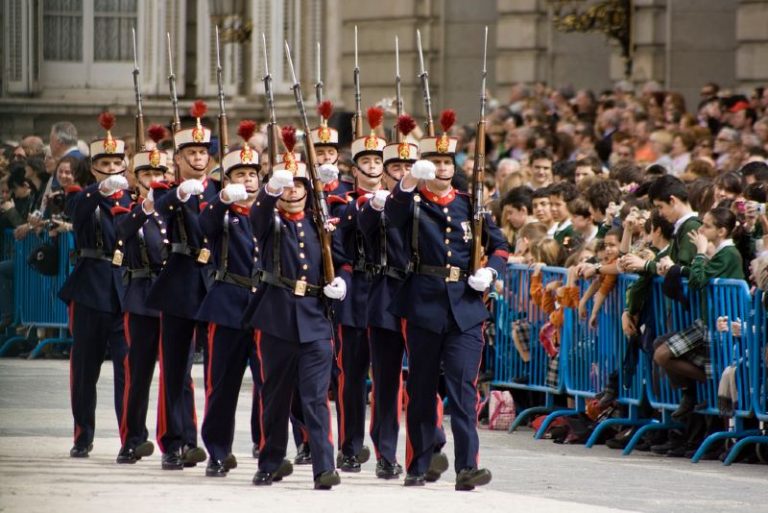
As I said before, Madrid is a pioneering city in converting commercial or industrial buildings into cultural spaces, and the Canal Foundation is a great example.
This cultural center was built in 2004 thanks to the Canal de Isabel II (publicly owned company responsible for the public water supply and wastewater collection for the city of Madrid), which converted part of the water storage facilities into an exhibition center called Canal Foundation. Actually, converting industrial buildings into cultural spaces is very common for the Canal de Isabel II, which already has several cultural centers and theaters in the city.
The building complex includes a huge water tank (40 meters high) built in 1939, offices for the Madrid Water and Sewer Department, green spaces, an auditorium and two exhibition halls (Sala Castellana 214 and Sala Mateo Inurria 2) where all kinds of art exhibitions take place: photography, sculpture, painting, etc.
Since 2004 this cultural center has hosted many exhibitions. Some of the most important have been: Terracotta Army (2005), Treasures of World Cultures (2009), Auschwitz (2018) or Game On, The History of Video Games (2019).
-Address: Paseo de la Castellana, 214
-Nearest Metro Station: Plaza de Castilla (lines 1, 9 and 10)
-Price: free entry (some exhibitions are not free)
-Schedule:
Few districts in the city preserve the traditional spirit and essence of Madrid like La Latina does.
This enchanting neighborhood surprises tourists with its picturesque mid-rise buildings (4-5 stories) with beautiful balconies, Baroque churches, and small theaters. This traditional atmosphere is called in Madrid “castizo“.
Due to the tourist boom in the city over the last 10 years, everyday lifelong residents of La Latina (mostly older people) mingle with tourists and young people, who come to La Latina to have a nice walk or have a “caña” (beer) in one of the many bars located in this area. To tell the truth, bars are one of the best reasons to visit this neighborhood of Madrid; La Latina is full of tiny bars, restaurants, traditional taverns, and bar terraces.
Tip for #Madrid.
If you stay anywhere in Madrid, make sure it’s the La Latina district.
The food, the bars, the buzz… Unrivalled. 😍— Michaela (@HeyImMichaela) October 27, 2019
Some of our favorite bars in La Latina are “Juana La Loca”, which prepares one of the best Spanish Tortillas in Madrid and “Casa Amadeo”, very popular for its snails in sauce.
On Sundays and bank holidays La Latina is home to the popular Mercado de El Rastro (one of the largest Flea Markets in Europe). From 9 a.m. until approximately 5 p.m. the streets of the neighborhood are flooded with locals and tourists in search of a bargain.
-Nearest Metro Station: La Latina (line 5)
-What to do? Stroll through its picturesque streets, enjoy the local atmosphere and eat “tapas”. Two of the most visited places in the neighborhood are the Cebada Food Market and the Church of San Francisco el Grande.
Ver esta publicación en Instagram
Una publicación compartida de Saskia van Ryneveld Actress (@sas_vr)
I can say, without fear of being wrong, that Madrid has one of the most incredible train stations in Europe.
I love traveling by train and, since I was a child, Atocha Train Station has always been one of my favorite places in Madrid; I like seeing the passengers with their luggage, the announcements over the public-address system, the smell of coffee from the cafeterias or the screens that indicate the train schedules.
Atocha Station in Madrid is made up of 5 areas linked together:
This makes Atocha Station the largest railway hub in Spain with more than 100 million passengers per year!!
Specifically, I would like to talk about my favorite area in Atocha, the old 19th century train station.
When the Spanish Government inaugurated the new train terminal, the old train station was completely abandoned. Instead of demolishing it, the government decided to preserve the spectacular iron, brick and ceramic structure and design a spectacular tropical garden (4,000 square meters) full of plants and trees from different parts of the world (America, Asia, and Australia).
The extreme climate of Madrid (few rains, cold winters, and very hot summers) is not the best for these tropical species. For this reason, a complex system of water sprinklers was installed to increase the humidity and lower temperatures during the soporific heat of summers in Madrid.
I’m sure that you will enjoy this place in Madrid. Throughout the tropical garden you will find benches for travelers and visitors to sit, shops, cafeterias, and restaurants.
-Address: Glorieta de Carlos V s/n (metro Atocha Renfe)
-Opening Hours: de 5:30 a.m. a 10:20 p.m.
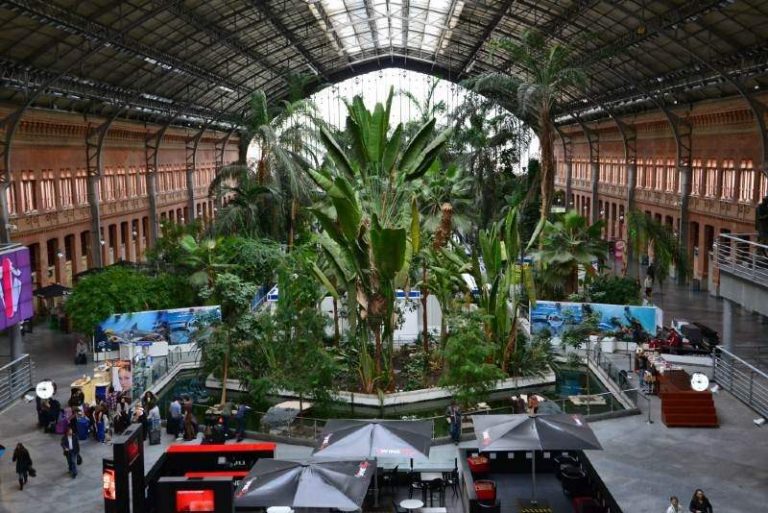
Few things are as typical of Madrid as a delicious bocadillo de calamares or fried squid sandwich. All over the city, far and wide, you’ll find bar posters offering bocadillos de calamares, but the best ones are definitely to be found around the Plaza Mayor. In particular, we recommend three bars where you can enjoy an authentic bocadillo de calamares:
-Price: The price of a bocadillo de calamares is around €3, a reasonable price for something in the city center. It is precisely its affordable price that attracts the hundreds of customers who stand in long lines each day.
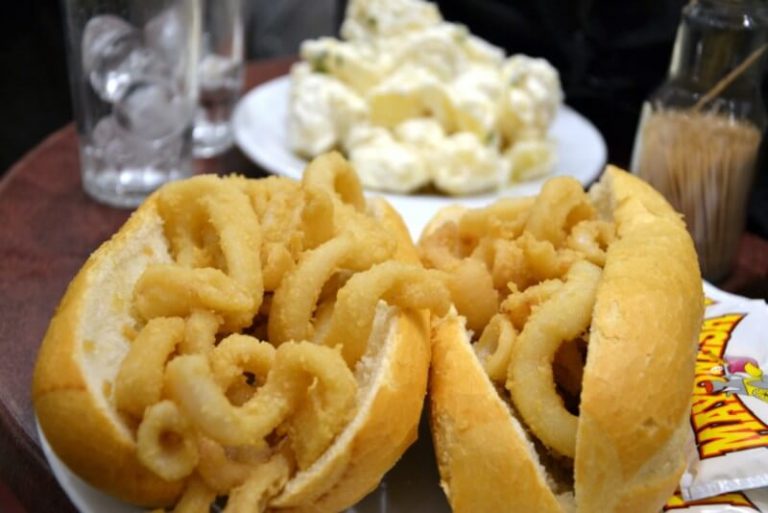
Now you have no excuse to enjoy Madrid, whatever your budget is! Find us on Facebook (OgoTours), Twitter (@OgoTours) and Instagram (OgoTours) for more insider tips!
If you are also travelling to Barcelona, check out Free Things to do in Barcelona from our friends from Runner Bean Tours! Czech Republic´s capital also has a great list of free things to do in Prague, check it out!

What to do in Madrid in 2 days Visiting Madrid in two days is a truly complicated task considering the city’s numerous attractions: incredible buildings,
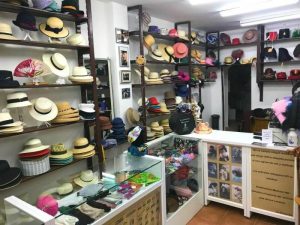
Tradional Shops in Madrid: Centuries-Old Family Businesses As a small local business, we love traditional shops in Madrid that keep their traditions intact from generation to

San Miguel Market in Madrid Located just outside the walls of Plaza Mayor, San Miguel Market has undoubtedly become one of the gastronomic landmarks in
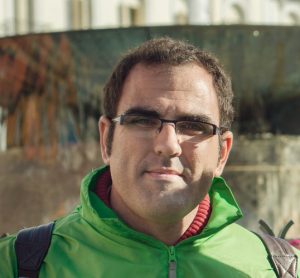
Hola! My name is Javier Redondo, tour guide in Madrid for more than 8 years.
As a good "Madrileño", I love football (I support Atlético de Madrid), eating tapas and walk the cobblestone streets of old Madrid 🙂
This Madrid blog is where I share tips on popular attractions, local food and off-beat spots.
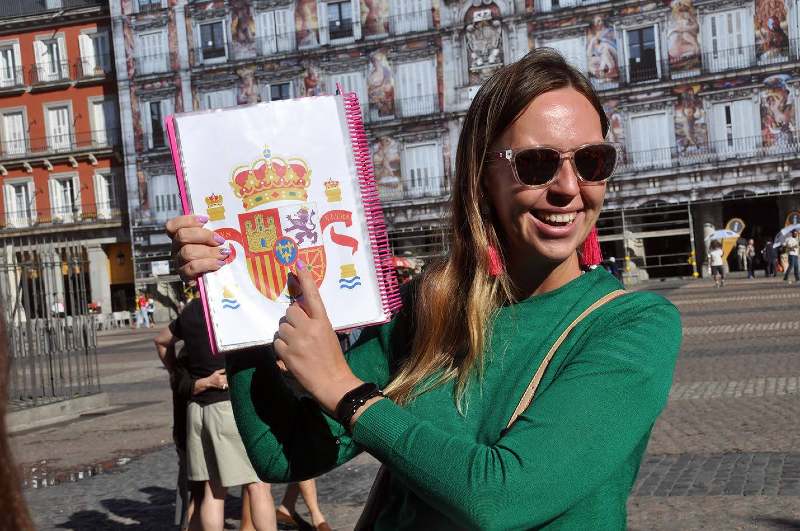
Based on 1000+ reviews
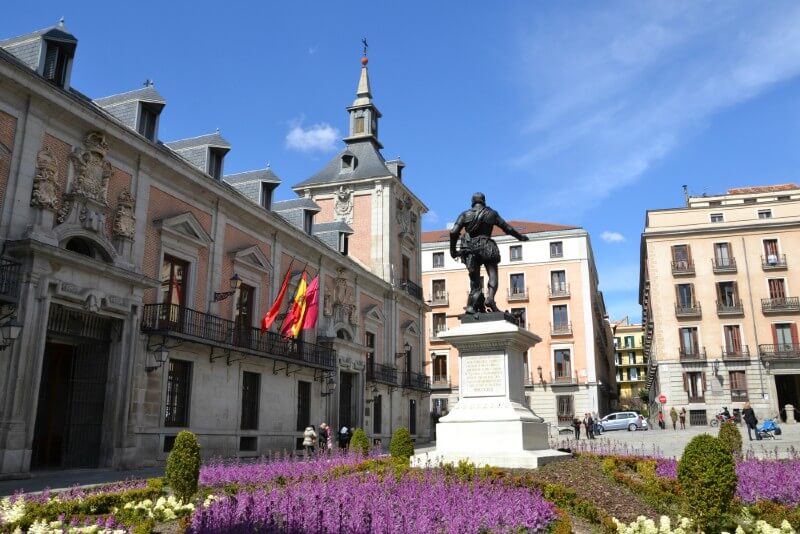

Copyright © OgoTours Madrid 2013-2023
OgoTours is a 100% local company. And as such, we are proud to do our bit to preserve the traditions and spirit of the city. Our goal is to help you experience Madrid like a local.
Tax Identification Number: 46890705F
If you need any additional information about our services, do not hesitate to contact us. We will be happy to answer all your questions.
Are you travelling around Spain? We are a proud member of Discover Our Cities. This network is made up of local tour opertators that share the same philosophy about tourism. All companies involved in this proyect have something in common; we are focused on offering 100% local and genuine experiences.
Our most popular posts:
The best panoramic views in Madrid
Our groups are now limited to 10 people, therefore it is required to book your spot in advance.
Mandatory use of face masks for guides and customers. Following the Spanish legislation, the wearing of face masks in all public spaces is obligatory.
When available, we highly recommend to maintain 2-meters social distancing between all the participants of the tour.
All our guides will be carrying hand sanitizer during the tour and it will be available during the whole route for you.
You will hear the explanations perfectly, as your guide will be carrying a voice amplifier.
You don´t need to print out your tour confirmation (just in case keep the email confirmation on your phone). Your name and last name will be enough for the guide to complete the check-in process.